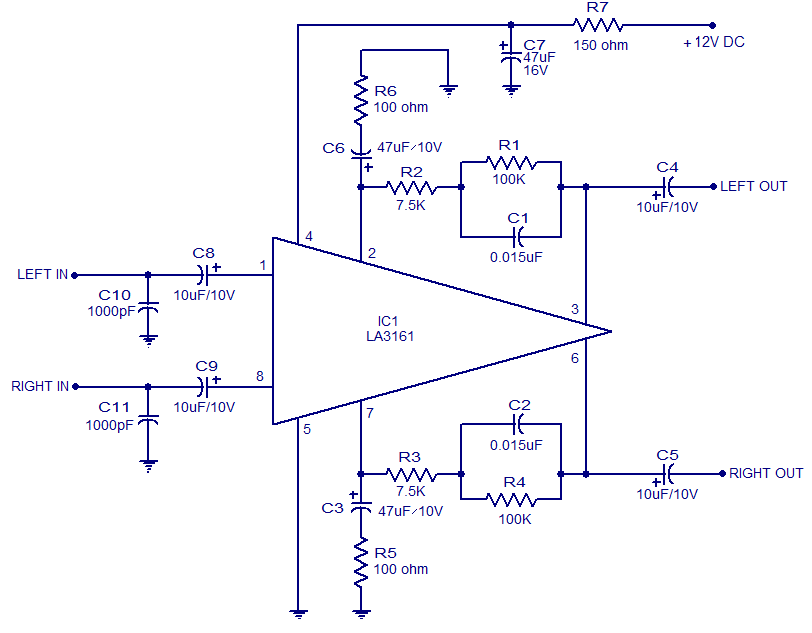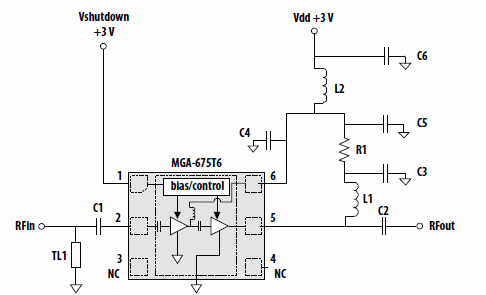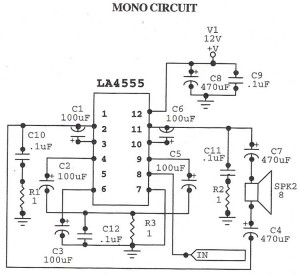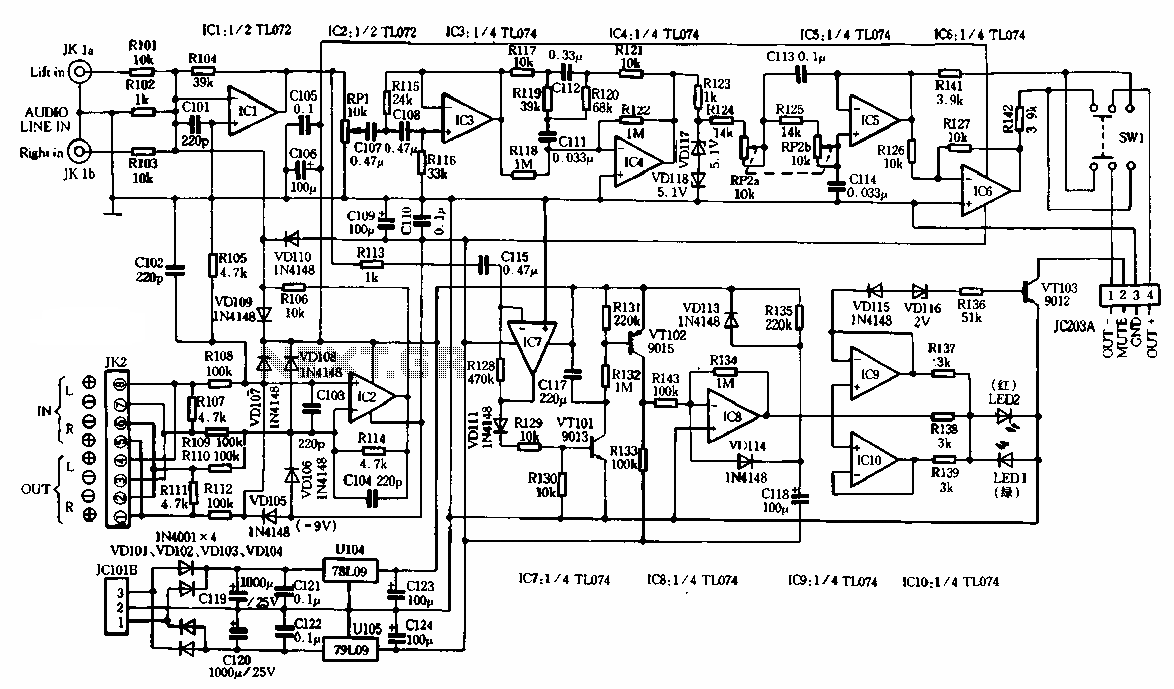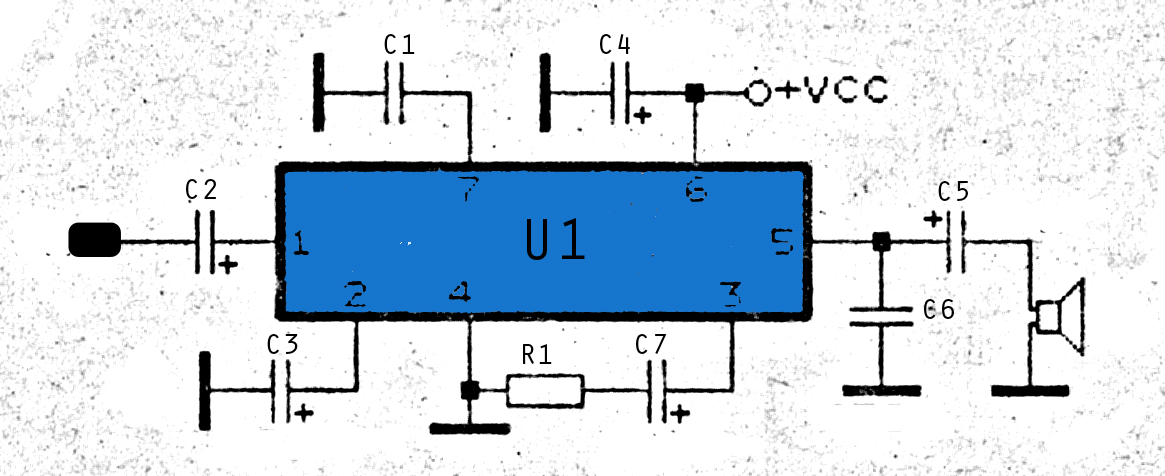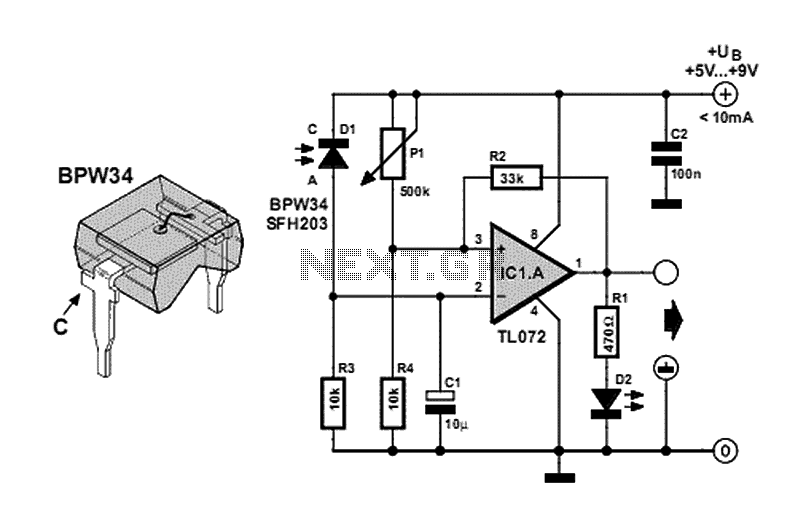
improved 3 transistor audio amp
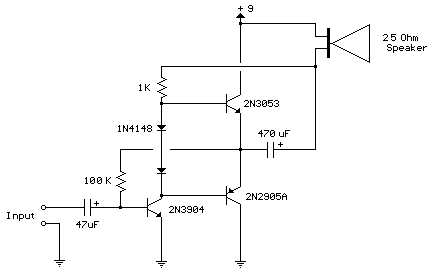
This circuit is similar to the previous one but employs positive feedback to enhance the amplitude delivered to the speaker. It is adapted from a small 5-transistor radio that utilizes a 25-ohm speaker. In the earlier circuit, the load resistor for the driver transistor is connected directly to the positive supply, which presents a disadvantage. As the output becomes positive, the voltage drop across the 470-ohm resistor decreases, leading to a reduction in base current to the top NPN transistor. Consequently, the output cannot reach the positive supply voltage because there would be no voltage across the 470-ohm resistor, resulting in no base current for the NPN transistor. This revised circuit addresses the issue to some extent, allowing for a larger voltage swing and potentially more output power, although the exact increase is uncertain without extensive testing. The output is still limited to a couple of volts when using small transistors since the peak current will not exceed approximately 100 mA into a 25-ohm load. However, it represents an improvement over the previous circuit. In this design, the 1kΩ load resistor is connected to the speaker, ensuring that as the output moves negative, the voltage across the 1kΩ resistor decreases, which assists in turning off the top NPN transistor. When the output moves positive, the charge on the 470µF capacitor aids in turning on the top NPN transistor. The original circuit in the radio utilized a 300-ohm resistor in place of the two diodes shown; however, the resistor was substituted with diodes to enable the amplifier to operate at lower voltages with reduced distortion. The transistors identified as 2N3053 and 2N2905 are components used in the earlier circuit but could be replaced with smaller alternatives. Any small transistors capable of handling 100 mA or more can be employed, although the 2N3904 or 2N3906 may be slightly undersized but could function at low volumes. The two diodes provide a relatively constant bias voltage as the battery discharges, helping to minimize crossover distortion. It is crucial to ensure that the idle current remains around 10 to 20 mA with no signal present and that the output transistors do not overheat under load conditions. The circuit is compatible with a standard 8-ohm speaker, although the output power may be somewhat diminished. To optimize performance, select a resistor in place of the 100kΩ to set the output voltage at half the supply voltage (4.5 volts). This resistor can range from 50kΩ to 700kΩ, depending on the gain characteristics of the transistor used in the circuit.
The circuit design incorporates a feedback mechanism that enhances the performance of the audio amplifier by utilizing positive feedback. The primary components consist of two NPN transistors, a capacitor, diodes, and resistors, which collectively facilitate the amplification process. The positive feedback loop is achieved through the strategic arrangement of the load resistor and the capacitor.
The 1kΩ load resistor connected to the speaker plays a critical role in managing the output signal. When the output signal swings negatively, the voltage across this resistor decreases, effectively turning off the top NPN transistor, which prevents distortion during the negative cycle of the audio waveform. Conversely, when the output swings positively, the charge stored in the 470µF capacitor provides additional base current to the top NPN transistor, enhancing its conduction and allowing for a stronger output signal.
The use of diodes in place of the resistor allows for better performance at lower supply voltages, which is particularly beneficial in battery-operated devices. The diodes maintain a stable bias voltage that adjusts as the battery discharges, minimizing crossover distortion which can adversely affect audio quality.
It is essential to ensure that the biasing of the output transistors is properly set to avoid overheating. The idle current should be carefully monitored, as excessive current can lead to thermal runaway conditions, potentially damaging the transistors.
Overall, this circuit represents a practical approach to audio amplification, balancing simplicity, efficiency, and performance, making it suitable for small-scale audio applications where space and power consumption are critical considerations.This circuit is similar to the one above but uses positive feedback to get a little more amplitude to the speaker. I copied it from a small 5 transistor radio that uses a 25 ohm speaker. In the circuit above, the load resistor for the driver transistor is tied directly to the + supply. This has a disadvantage in that as the output moves positive, the drop across the 470 ohm resistor decreases which reduces the base current to the top NPN transistor. Thus the output cannot move all the way to the + supply because there wouldn`t be any voltage across the 470 resistor and no base current to the NPN transistor.
This circuit corrects the problem somewhat and allows a larger voltage swing and probably more output power, but I don`t know how much without doing a lot of testing. The output still won`t move more than a couple volts using small transistors since the peak current won`t be more than 100mA or so into a 25 ohm load.
But it`s an improvement over the other circuit above. In this circuit, the 1K load resistor is tied to the speaker so that as the output moves negative, the voltage on the 1K resistor is reduced, which aids in turning off the top NPN transistor. When the output moves positive, the charge on the 470uF capacitor aids in turning on the top NPN transistor.
The original circuit in the radio used a 300 ohm resistor where the 2 diodes are shown but I changed the resistor to 2 diodes so the amp would operate on lower voltages with less distortion. The transistors shown 2n3053 and 2n2905 are just parts I used for the other circuit above and could be smaller types.
Most any small transistors can be used, but they should be capable of 100mA or more current. A 2N3904 or 2N3906 are probably a little small, but would work at low volume. The 2 diodes generate a fairly constant bias voltage as the battery drains and reduces crossover distortion. But you should take care to insure the idle current is around 10 to 20 milliamps with no signal and the output transistors do not get hot under load.
The circuit should work with a regular 8 ohm speaker, but the output power may be somewhat less. To optimize the operation, select a resistor where the 100K is shown to set the output voltage at 1/2 the supply voltage (4. 5 volts). This resistor might be anything from 50K to 700K depending on the gain of the transistor used where the 3904 is shown.
🔗 External reference
The circuit design incorporates a feedback mechanism that enhances the performance of the audio amplifier by utilizing positive feedback. The primary components consist of two NPN transistors, a capacitor, diodes, and resistors, which collectively facilitate the amplification process. The positive feedback loop is achieved through the strategic arrangement of the load resistor and the capacitor.
The 1kΩ load resistor connected to the speaker plays a critical role in managing the output signal. When the output signal swings negatively, the voltage across this resistor decreases, effectively turning off the top NPN transistor, which prevents distortion during the negative cycle of the audio waveform. Conversely, when the output swings positively, the charge stored in the 470µF capacitor provides additional base current to the top NPN transistor, enhancing its conduction and allowing for a stronger output signal.
The use of diodes in place of the resistor allows for better performance at lower supply voltages, which is particularly beneficial in battery-operated devices. The diodes maintain a stable bias voltage that adjusts as the battery discharges, minimizing crossover distortion which can adversely affect audio quality.
It is essential to ensure that the biasing of the output transistors is properly set to avoid overheating. The idle current should be carefully monitored, as excessive current can lead to thermal runaway conditions, potentially damaging the transistors.
Overall, this circuit represents a practical approach to audio amplification, balancing simplicity, efficiency, and performance, making it suitable for small-scale audio applications where space and power consumption are critical considerations.This circuit is similar to the one above but uses positive feedback to get a little more amplitude to the speaker. I copied it from a small 5 transistor radio that uses a 25 ohm speaker. In the circuit above, the load resistor for the driver transistor is tied directly to the + supply. This has a disadvantage in that as the output moves positive, the drop across the 470 ohm resistor decreases which reduces the base current to the top NPN transistor. Thus the output cannot move all the way to the + supply because there wouldn`t be any voltage across the 470 resistor and no base current to the NPN transistor.
This circuit corrects the problem somewhat and allows a larger voltage swing and probably more output power, but I don`t know how much without doing a lot of testing. The output still won`t move more than a couple volts using small transistors since the peak current won`t be more than 100mA or so into a 25 ohm load.
But it`s an improvement over the other circuit above. In this circuit, the 1K load resistor is tied to the speaker so that as the output moves negative, the voltage on the 1K resistor is reduced, which aids in turning off the top NPN transistor. When the output moves positive, the charge on the 470uF capacitor aids in turning on the top NPN transistor.
The original circuit in the radio used a 300 ohm resistor where the 2 diodes are shown but I changed the resistor to 2 diodes so the amp would operate on lower voltages with less distortion. The transistors shown 2n3053 and 2n2905 are just parts I used for the other circuit above and could be smaller types.
Most any small transistors can be used, but they should be capable of 100mA or more current. A 2N3904 or 2N3906 are probably a little small, but would work at low volume. The 2 diodes generate a fairly constant bias voltage as the battery drains and reduces crossover distortion. But you should take care to insure the idle current is around 10 to 20 milliamps with no signal and the output transistors do not get hot under load.
The circuit should work with a regular 8 ohm speaker, but the output power may be somewhat less. To optimize the operation, select a resistor where the 100K is shown to set the output voltage at 1/2 the supply voltage (4. 5 volts). This resistor might be anything from 50K to 700K depending on the gain of the transistor used where the 3904 is shown.
🔗 External reference
